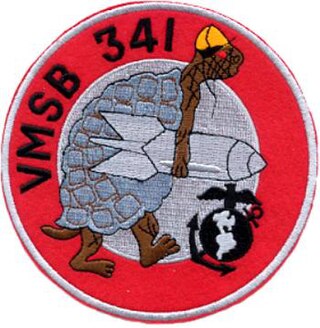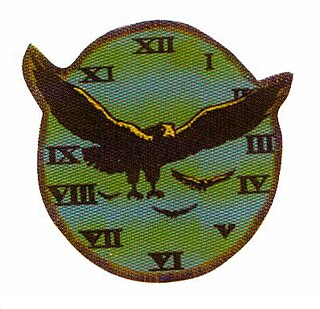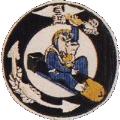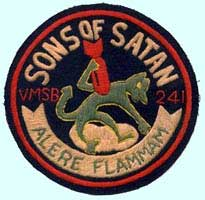
Marine Aircraft Group 32 (MAG-32) was a United States Marine Corps aviation unit established during World War II.

Marine Fighting Squadron 313 (VMF-313) was a reserve fighter squadron in the United States Marine Corps. They were a part of the 4th Marine Aircraft Wing and stationed at Naval Air Station New York. Also known as the "Lily Packin' Hellbirds" and the "Lilly Packin' Death Falcons", they fought in World War II mainly during the Philippines Campaign, 1944-45. The squadron was decommissioned in the 1950s.

Marine Fighting Squadron 132 (VMF-132) was a fighter squadron in the United States Marine Corps. The squadron, also known as "The Crying Red Asses", fought in World War II as a dive bomber unit during the Battle of Guadalcanal as part of the Cactus Air Force and later fought in the Central Solomon Islands. The squadron was decommissioned shortly after the end of the war but was reactivated in the Marine Air Reserve flying out of Floyd Bennett Field in Brooklyn, New York. They were again decommissioned sometime after 1958.

Marine Attack Squadron 144 (VMA-144) was a reserve Douglas A-4 Skyhawk attack squadron in the United States Marine Corps. Originally known as VMSB-144, the squadron saw its first combat in World War II as part of the Cactus Air Force during the Battle of Guadalcanal and also provided close air support during the Bougainville campaign (1943-1945). Following the war the squadron was deactivated but later became part of the Marine Air Reserve and was based out of Naval Air Station Jacksonville and then Naval Air Station Cecil Field, Florida.

Marine Scout Bombing Squadron 243 (VMSB-243) was a dive bomber squadron in the United States Marine Corps. The squadron, also known as the “Flying Goldbricks”, fought in World War II during the Battle of Bougainville and later in the Philippines campaign (1944–45). They were deactivated shortly after the end of the war on September 25, 1945.

Marine Scout-Bomber Squadron 341 (VMSB-341) was a dive bomber squadron in the United States Marine Corps. The squadron, also known as the “Torrid Turtles”, fought in World War II with Marine Aircraft Group 24, most notably in the Philippines campaign (1944–45). They were deactivated shortly after the end of the war on September 13, 1945.

Marine Operational Training Group 81 (MOTG-81) was a United States Marine Corps aviation training group that was established during World War II. Squadrons from MOTG-81 trained pilots, aircrew and ground crew on the PBJ-1 medium bomber. The Marine Corps divested its medium bomber fleet immediately after the war and the Group was decommissioned in December 1945.

Marine Fighting Squadron 215 (VMF-215) was a fighter squadron of the United States Marine Corps that was commissioned and fought during World War II. Known as "The Fighting Corsairs", the squadron fought in many areas of the Pacific War, including the Battle of Bougainville. During its four-and-a-half month tour, the squadron was credited with shooting down 137 enemy aircraft, fourth most in Marine Corps aviation history.
Marine Fighting Squadron 413 (VMF-413) was a fighter squadron of the Marine Forces Reserve during the Cold War. It descended from bombing squadron VMB-413, which was the Marine Corps' first medium bomber squadron and had fought during World War II. Best known as "Night Hecklers" and the "Shamrocks", the squadron fought in many areas of the Pacific War.

Marine Attack Squadron 543 (VMA-543) was an aviation unit of the United States Marine Corps. The squadron, also known as the "Night Hawks", were part of the Marine Forces Reserve and were based at Naval Air Station Glenview, Illinois until their deactivation on 1 April 1974. Originally activated during World War II, they fought in the Battle of Okinawa as part of the Tactical Air Force. The squadron was credited with downing 15 Japanese aircraft during the war. Following the surrender of Japan, the squadron was deactivated only to be later reactivated as part of the Reserves. They were again deactivated in 1974 and remain in an inactive status today.
Emirau Airport is an airfield in Emirau Island, Papua New Guinea.

Marine Attack Squadron 143 (VMA-143), nicknamed the Rocket Raiders, was a reserve attack squadron in the United States Marine Corps. Originally commissioned during World War II, the squadron fought at the Guadalcanal, New Georgia, the Battle of Bougainville, Battle of Okinawa, and the Battle of Balikpapan.

Marine Air Control Squadron 7 (MACS-7) was a United States Marine Corps aviation command and control squadron. The squadron provided aerial surveillance and ground-controlled interception and saw action most notably during the Battle of Okinawa in World War II and the Vietnam War. They were last based at Marine Corps Air Station Yuma and fell under the command of Marine Air Control Group 38 (MACG-38) and the 3rd Marine Aircraft Wing.
Air Warning Squadron 2 (AWS-2) was a United States Marine Corps aviation command and control squadron during World War II. The squadron was tasked to provide aerial surveillance and early warning during amphibious assaults. They took part in the Battle of Guam in 1944 and would eventually move to Peleliu in 1945 assuming responsibility for air defense in that sector until the end of the war. The squadron departed Peleliu for the United States in January 1946 and was quickly decommissioned upon its arrival in California. To date, no other Marine Corps squadron has carried the lineage and honors of AWS-2 to include Marine Air Control Squadron 2 (MACS-2).
Assault Air Warning Squadrons were United States Marine Corps aviation command and control units formed during World War II to provide early warning, aerial surveillance, and ground controlled interception during the early phases of amphibious landing. These squadrons were supposed to be fielded lightweight radars and control center gear in order to operate for a limited duration at the beginning of any operation until larger air warning squadrons came ashore. Four of these squadrons were commissioned during the war with one, AWS(AT)-5, taking part in the Battle of Saipan. All four squadrons were decommissioned on November 10, 1944 because the Marine Corps was unable to field the required mobile radars. The "first in" capability that the Assault Air Warning Squadrons were supposed to provide was transferred to the Early Warning Teams that were added to the tables of organization for the regular air warning squadrons.

Marine Attack Squadron 241 (VMA-241) was an aircraft squadron of the United States Marine Corps, known as the "Sons of Satan". The squadron was commissioned during World War II and took part in the Battle of Midway, sustaining 75% losses. It was extensively involved in combat while providing close air support during the 1944–1945 Philippines Campaign. The squadron, equipped with A-4 Skyhawk light attack aircraft, became part of the Marine Forces Reserve, based at Naval Air Station Los Alamitos, California, from 1946 until the 1960s.

Marine Fighter Squadron 541 (VMF-541) was a reserve fighter squadron of the United States Marine Corps. Originally commissioned during World War II as a night fighter unit flying the F6F-5N Hellcat, the squadron participated in combat action over Peleliu and while supporting the liberation of the Philippines in 1944–45. During the war, VMF(N)-541 was credited with downing 23 Japanese aircraft. Following the war, the squadron participated in the occupation of Northern China until returning to the States to be decommissioned on 20 April 1946. The squadron was reactivated sometime after the war in the Marine Corps Reserve until being decommissioned again in the early 1960s.
Marine Air Defense Command 1 (MADC-1) was a United States Marine Corps aviation command and control unit based in Okinawa, Japan. Originally commissioned in April 1944 as Marine Aircraft Group 62 (MAG-62), the higher headquarters for new PBJ squadrons that were training on the east coast of the United States. In late 1944, MAG-62 was tasked with joining the 2nd Marine Aircraft Wing on Okinawa to serve as an additional headquarters element for all of the disparate forces that fell under the command of the Tactical Air Force, Tenth Army. On August 15, 1945, MAG-62 was re-designated as Marine Air Defense Command 1. MADC-1 was a short lived unit that was decommissioned on November 30, 1945, shortly after the surrender of Japan.

Marine Photographic Squadron 254 (VMP-254) was a United States Marine Corps photographic reconnaissance squadron that was originally commissioned during World War II as a replacement training unit. In 1944 the squadron transitioned to the Fleet Marine Force and eventually deployed overseas in August 1945. During the war, the squadron flew the F6F-3P Hellcat and later transitioned to the Grumman F7F Tigercat. VMP-254 was decommissioned on November 30, 1949. Since that date, no other Marine Corps squadron has carried the lineage and honors of VMP-254.
Marine Attack Squadron 611 (VMA-611) was an attack squadron in the United States Marine Corps Reserve. The squadron was originally commissioned as a medium bomber squadron flying PBJ-1C/Ds during World War II. VMB-611 was the only Marine bomber squadron to operate in the Philippines during the war and was quickly decommissioned following the surrender of Japan. The squadron was reactivated as an attack squadron in the Reserves in 1958 at Naval Air Station Glenview, Illinois. It was later relocated to Naval Air Station Los Alamitos, California in 1968, and finally decommissioned in 1969.














